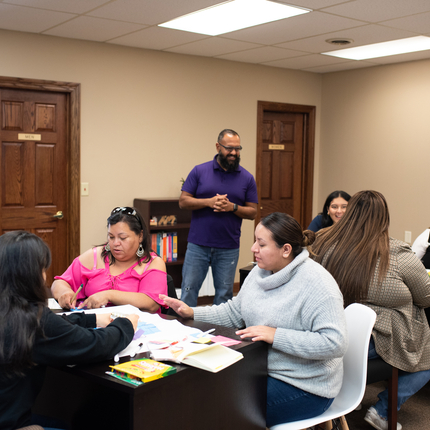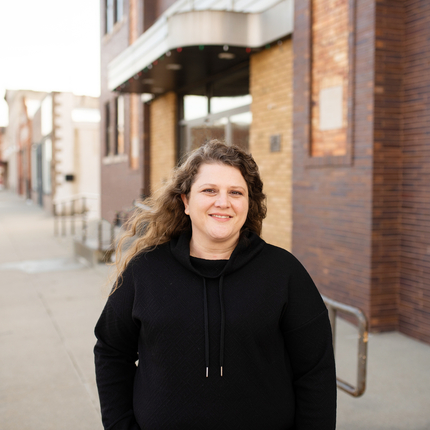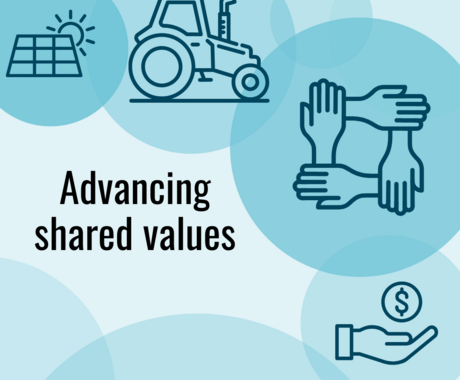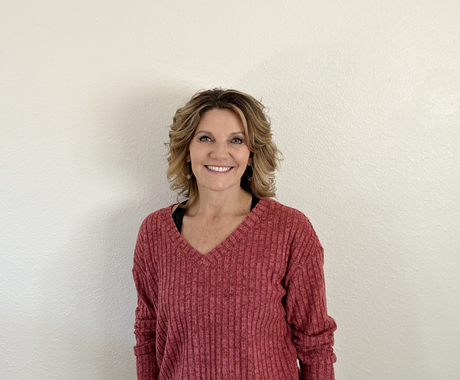The Center for Rural Affairs is set apart from its peers nationally by the holistic way it takes a look at rural communities.
“We’re also thinking about the resiliency of these communities, the people, the leaders, the businesses, and all the spaces where they go to enjoy full engagement in civic, social, and economic life,” said Sandra Renner, director of Farm and Community.
All this work is done alongside community members, local partners, and national partners.
As the Center celebrates 50 years, we mark decades of thriving communities and take note of the struggles they have faced.
Remembering the past
“When I was younger, I knew the Center was mostly focused on policy issues as it related to farming. That was something that we were very much keyed into during the farm crisis,” Sandra said. “As an adult returner to this part of the state, I looked at the organization as a place I wanted to work. It seemed like an organization that worked on positive change and valued rural people and places, which are things I value myself.”
She previously worked in social services with clients receiving economic assistance benefits like SNAP and energy assistance. And she often reflected on what she saw in the field.
“I became aware that basic skills—cooking and gardening, producing and processing meat—were not handed down in a lot of families like mine for a variety of reasons,” Sandra said. “What also stuck out to me was that some of my clients were living in rural areas but they had been systematically excluded or disinvested in. The economic programs made to supplement their lives were not really helping that much.”
As director of Farm and Community, she works to create programs that help people fill in the gaps.
“I hold a personal belief that everyone, especially children, have a right to nutritious fresh local foods, especially in rural places,” Sandra said.
Speaking up
The Center was started in 1973 in Walthill, Nebraska, by rural Nebraskans concerned about the loss of economic opportunity in agriculture and the decline of rural communities.
Through the years, the work has advanced, just like small towns have evolved, to focus on solutions and building a more resilient rural America.
“We’ve established ourselves in the past 50 years so we’re no longer that scrappy small nonprofit,” Sandra said.
Today, the Center’s community development and food systems work centers on building local capacity through training, relationship development, and hands-on assistance in farm and food, equity, and community development. Although primarily focused in Nebraska, this area of work reaches neighboring states too.
“My vision is to look at the big picture of rural Nebraska as it is today and the potential for what it could and will become in the next 20 years and share that with other rural places,” said Sandra. “We really focus on replicability and programs that apply to rural communities no matter where you are. We just get to pilot them in the Center’s backyard.”
Staff provide outreach and education to help beginning farmers with production conservation practices as well as the business aspects of starting and running a farm, and marketing the results.
They help communities develop solutions to issues like food access and food security—working alongside leaders to help rebuild their food systems through food sovereignty, in some cases.
“We also assist communities where demographics are shifting; we want to be more responsive to that,” Sandra said. “That might mean creating public art, community gardens, or farmers market spaces that all of the community can feel welcome in. It also creates a business opportunity for some of our other participants to take advantage of.”
Services such as providing translation support or intercultural leadership training to agencies and organizations have been added in the past few years.
“We often look for voices that aren’t at the table or are often systematically excluded in finding solutions that will work for them,” Sandra said. “We’ve found ways to be more intentional with audiences that tend to get left behind. That’s the intent of the organization.”
Often, this means staff need to have an understanding of what it means to live, work, or start a farming operation or business on reservation land and other rural places.
“These are just a few of the realities and dynamics of rural Nebraska, and certainly, rural America,” she said. “That’s where we tend to focus, that holistic approach.”
Following Sandra’s Center journey
Stepping into her program director role in 2019, Sandra is no stranger to work in rural communities. Her family’s roots are in northeast Nebraska.
Sandra was drawn to the Center and a job focused on food systems. She started working on farm to school—something she had never heard of. Her first task was to help launch a new pilot program in 12 rural schools in Nebraska that helped the schools return to finding ways to source local foods for their meal programs. The project also helped teach children about where their food comes from, how to raise it, what it does for them nutritionally, and economic impacts on their local communities. Sandra also helped connect farmers with schools.
While in the schools, she and her program partner became aware there were a lot of empty greenhouses across the state. So, in 2015, Sandra was involved in another pilot, the Greenhouse to Cafeteria program, which helped schools fill their empty buildings with food for students’ lunches.
“We framed up the pilot on helping schools do more if they do not have access to a local farmer,” Sandra said. “In addition, we’d be creating beginning farmers when we partnered with ag and FFA instructors to help them figure out a production plan, put together a farm to school team at the schools, and teach growing practices.”
Sandra then took on new work with female nonoperator landowners—in particular, working with women who were navigating inherited land. She helped develop resources and education opportunities focused on topics such as farming in a changing climate, how to navigate leases or hunting rights on your property, and implementing conservation practices with their operators.
“Sometimes they wanted to find new operators who shared their visions because they inherited their operator from their dad and they had a different vision for the land, or they knew their father’s vision and this operator really wasn’t cutting it,” she said. “Most importantly, we just connected them to one another through learning circles for peer-to-peer sharing and learning.”
At about the same time, Sandra also helped with work focused on women who were beginning farmers, many of whom were interested in bringing value-added products to market or selling to schools. She became aware of issues in navigating and licensing commercial kitchens.
Sandra learned licensing commercial kitchens was handled differently in Omaha, Lincoln, and Grand Island compared to the other 90 counties in the state. She created a toolkit, started a helpline, and hosted tours of licensed kitchens, inviting state inspectors to connect with participants.
“This funding was for a few counties in northeast Nebraska, but I got calls from all over the state and nationally,” she said. “I knew what we were doing was replicable and we could share it with others. There were some real impacts of this project.”
The Center’s community work, from farm-to-school to navigating licensed kitchens, has national reach. Staff pilot this and other programs, and focus on replicability in rural communities across the country.
In 2017, Sandra expanded her knowledge of the Center’s support work by helping with communications outreach. She helped distribute press releases, edit blogs, and create media lists.
Then, her role evolved to support work with foods and arts-based businesses, organizing a conference that brought in experts from across the country.
“People from northeast Nebraska, including the UMÓⁿHOⁿ Nation, were able to get resources and think about placemaking through food and the arts and the real viability and demand for those kinds of businesses,” Sandra said.
In 2018, she started overseeing community development work around welcoming, belonging, and inclusion.
“We provide support to community leaders in advocating to new audiences in their communities and helping them build capacity around language accessibility, their welcoming efforts as well as supporting and developing intercultural and resilient leaders,” she said.
Her current role as program director was cemented in 2019.
“I felt I uniquely understood what our audience needs were and had gotten very hands on with a lot of our work in communities, with farmers and landowners,” Sandra said. “I also had gotten more involved with work with communities focusing on welcoming and inclusion and food sovereignty efforts with Nebraska Tribes. In a way, that was really important to carry into the next director role.”
Looking toward the future
The future of the Center’s work is designed with input from community members and farmers. They share what their challenges are, and staff provide them with resources and support to take the next steps forward. Future focuses of work are decided with these needs in mind.
“We can also connect community members to what I like to call the total package of the Center,” Sandra said. “If there’s a systemic issue that requires policy advocacy, we connect them to our staff focused on state or federal level policy. Do they need assistance with a business or home loan or technical assistance? We can connect them with our lending specialists.”
Top photo: Since 1973, the Center has stood alongside those who have been systematically excluded, including engaging Latino leaders. | Photos by Kylie Kai
Middle photo: The Center works alongside leaders to develop solutions to issues like food access and food security. Pictured, a nutrition workshop for the community at Nebraska Indian Community College on UMÓnHOn Nation.
Bottom photo: Farm & Community Director Sandra Renner’s vision is to look at the big picture and potential of rural Nebraska and share that with other rural places.







